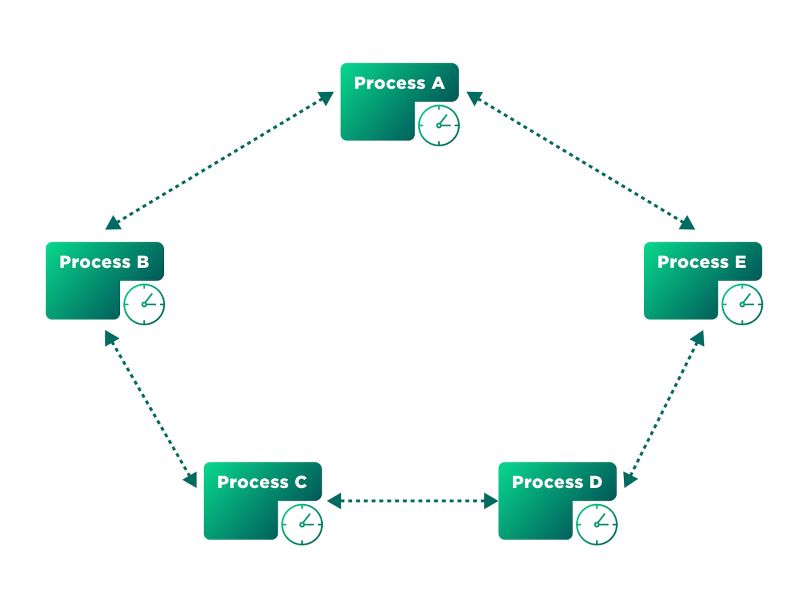In the head-spinning world of crypto, the hashgraph consensus in blockchain stands out. You might wonder if it’s just a buzzword or truly a game changer for blockchain efficiency. Well, I’ve dived headfirst into the tech that promises to speed up and secure our digital transactions like never before. It’s all about gossip—but not the kind you’re thinking of—and a clever way of voting that cuts out delays. Let’s cut through the hype and see if this tech will rule or simply fade away. Buckle up, we’re about to ride the hashgraph wave, and I’m here to tell you how it stacks up against our old blockchain pal.
Understanding Hashgraph: Beyond Blockchain
Demystifying Hashgraph Technology and Its Foundations
You may ask, “What is hashgraph?” Think of hashgraph like a network diary. It keeps record of who said what and when. This is how it tracks transactions. It’s like a group chat for computers where everyone talks about what they know. Everyone learns the news without needing to hear it from everyone. This is due to the Gossip about Gossip protocol.
Hashgraph relies on this gossip system. Picture kids whispering a secret around a circle. Each computer shares the latest gossip. But instead of rumors, it’s transaction data. This way, all have the full story quickly. It’s fast and uses less power than blockchain.
Now, how does hashgraph work with this gossip? Well, hashgraph uses math to avoid voting. The math confirms if the network trusts a piece. This is the Virtual Voting algorithm. This process is super clever, and it’s what makes hashgraph quick and trusty.
Hashgraph vs Blockchain: Core Differences
Hashgraph is not like blockchain. It does not line up blocks of data. It connects them like a web, all helping to share the full story. This is the DAG (Directed Acyclic Graph) data structure at play, linking events in a forward motion, showing a clear history without the need for blocks.
This web is way faster than blockchain’s single line of blocks. It also means everyone agrees on the order events came in, which is fair ordering. That’s important for business, where time is money!
Hashgraph also has no mining. Mining is when computers work hard in blockchain to add blocks. Since hashgraph skips this step, it also skips the intense competition and energy burn. Picture a race without all the jostling and pushing, but with everyone finishing at once.
In blockchain, everyone fights to add a block. It’s like a puzzle race. The winner gets rewards. But with hashgraph’s gossip, there’s no race. Instead, everyone works together. They reach a deal on transactions without that fight. Peaceful, right?
With blockchain, you might hear “proof of work” or “proof of stake”. These are ways to agree on what’s true. Hashgraph doesn’t use these. It’s got its own tricks, and they are quite neat. Because hashgraph doesn’t compete, it saves energy. This can be good for our earth.
Hashgraph has a patent, it’s true. This means its code is locked down by its creators. Some say this hurts its spread. Others see it as a way to keep it safe. It’s a hot debate in the world of code and tech.
On the subject of safety, hashgraph’s security is tough as nails. Hackers have a hard time breaking into the web of gossip. The connections are strong.
Blockchains are public, like a park. Private ones are like your backyard. Both have their uses. Hashgraph fits either way. It can handle closed-door business needs or wide-open public ones.
Swirlds is the company that made hashgraph. They want businesses to trust its speed and smarts. They made the HBAR token to fuel the network. Some find this exciting for things like money and legal papers.
Experts argue if hashgraph is the next top tech. Will it change how we talk, pay, and trust online? It sure has bright ideas to share. For me, it’s like a puzzle to solve, a chance to dream up new ways for tech to help us all. It all boils down to one fact: hashgraph might just spin the tech world round, with its web of speedy whispers.
The Mechanics of Hashgraph Consensus
Exploring the Gossip About Gossip Protocol
Ever wonder how hashgraph works? It’s all about gossip. Yes, you heard it right! Hashgraph uses a method called “Gossip about Gossip” to share information. This may sound like playground talk, but it’s actually a smart way for computers to quickly and efficiently mix data.
Here’s how it goes. Imagine everyone at a party whispers a rumor from one person to the next. But instead of whispering just the latest rumor, each person also tells where they heard each past rumor from. That’s pretty much what happens in Gossip about Gossip. Each computer in the hashgraph network shares what they know, plus a bit about how they know it.
This protocol means info moves fast and reaches everyone without mess-ups. It’s a reliable trick that the hashgraph network uses to reach an agreement, or consensus, without needing everyone to chat all at once. Because if they did, it would be one big, confusing noise!
Gossip about Gossip is clever because it can handle lots of transactions at the same time. This is a big win for hashgraph’s speed. It’s also more private than other tech, so your secrets are safer.
Delving into Virtual Voting Algorithms
But how does hashgraph make sure everyone agrees on what’s what? It uses something called Virtual Voting. This sounds like a TV show where you text your favorite singer to win, but it’s way more science than that.
Think of Virtual Voting like a super smart guess of how others would vote on new info, without asking them directly. So, everyone gets a say without saying a word. This helps the hashgraph decide what data is legit in record time.
What’s cool is, thanks to the Gossip about Gossip method, every member knows enough about how others have voted in the past. So they can assume how they’ll vote now. This is what makes hashgraph really fast.
By combining these two neat tricks – gossiping everything and smart guessing votes – hashgraph can quickly line up transactions in order. This means no one can cheat by slipping in line. Everything is fair and square.
What we get from this is a system that makes deals fast and with no mess. It’s like a busy bee that knows where every other bee is and what it’s doing, all the time. This means hashgraph has the upper hand over regular blockchains when we talk about speed and doing lots of things at once without a hitch.
In simple speak, hashgraph technology is like your favorite superhero: it’s quick, smart, and does the job well – protecting your info and making deals zip by. Whether we chat about sending money, voting, or other smart tasks, hashgraph has it covered.
Now, hashgraph ain’t perfect – no hero is. But it’s proving to be a big leap from the old ways of doing things in the wild world of blockchain. And when I think about where tech is heading, I can’t help but tip my hat to these smart cookie methods that keep making our digital lives better and brighter.
Evaluating Hashgraph Performance and Applications
Hashgraph Efficiency and Transaction Speed
Ever wondered why hashgraph technology is a hot topic? It’s fast! That’s the simple truth. Now, let’s dig a bit deeper. Hashgraph is like a special club that lets data spread quickly. This speed comes from something called Gossip about Gossip protocol. It’s like a game of telephone but way smarter. Every member whispers to a few friends, and soon everyone knows everything.
Why does this matter? Well, traditional blockchain can get slow. They often take turns to add new info. Hashgraph doesn’t wait. Instead, it gossips to reach a consensus on what order things happened. And it does this super fast. The actual hashgraph transaction speed? Some say it can handle over 10,000 transactions per second. That’s like a whole city’s worth of talking happening in a single second!
Real-World Use Cases: Hashgraph in Action
So, where is hashgraph making a splash? Lots of places! Companies love it for its speed and security. For example, we see hashgraph in health care, keeping patient records safe. It’s also in gaming, making sure players can trust the system. Even big companies use hashgraph to track goods from far away lands to our doorsteps.
Why so popular? Hashgraph is not just fast but it’s also very secure. It uses fancy math called the Virtual Voting algorithm to make sure nobody cheats. It’s a way of double-checking votes on who got what data and when. Plus, the hashgraph network can store all kinds of stuff, from money, like its HBAR token, to secret messages.
But there’s more. Hashgraph isn’t just for the big guys. Developers can build apps on it, without stepping into the public vs private blockchain debate. They can make new things for the Hedera Hashgraph platform – that’s the biggest hashgraph out there! And for businesses? They can use hashgraph for enterprise stuff, like keeping tabs on who owns what. Or making sure their stuff is really, really secure.
Now, is hashgraph perfect? Nope. It’s still new, and some people worry because it’s patented. Not everyone can use it freely like most blockchain stuff. But as more people learn about it, who knows what cool things they’ll make? What we do know is, hashgraph has some nifty tricks that make it a tech worth watching.
Future Trajectory and Adaptation of Hashgraph
Hashgraph’s Prospects in Cryptocurrency and Beyond
What is hashgraph? It’s a tech for sharing data that’s fast and safe. People often ask about hashgraph vs blockchain. Both store transactions, but hashgraph works differently. It’s based on a DAG, not a chain of blocks. This means hashgraph can handle more transactions at once, which boosts its transaction speed and efficiency.
Why is speed important? In the world of buying and selling with digital money, every second counts. Slower systems can clog up, especially when lots of people use them at once. Hashgraph keeps things flowing smoothly. With its Gossip about Gossip protocol, it spreads data like wildfire.
How does hashgraph work? It chats. Yes, you heard that right. Each piece of data tells two others, and so on. It’s like a game of telephone but with a catch. The catch is trust. Every member gets a voice in virtual voting to agree on what happens and when. This quick back-and-forth builds a web of agreement that keeps everyone on the same page, without the need for every member to chat with every other one.
Now, what about security? Hashgraph doesn’t play games here. Because everyone talks so much, it’s tough for sneaky lies to spread. This makes the hashgraph network harder to fool.
Can hashgraph grow? Yes, it can grow bigger without getting clumsy. This is the magic of hashgraph scalability. But with great tech comes great responsibility. Hashgraph must show that it’s not just a gadget for tech fans but a real tool that can change the game. This means finding its way into apps we use every day.
Overcoming Patent Hurdles: Fostering Developer Engagement
Regarding hashgraph vs blockchain, one hot topic is the hashgraph patent. The team behind hashgraph, called Swirlds, has kept a tight grip on it. Why does this matter? In the world of building new tech, sharing is caring. When creators can mix ideas, they make even cooler stuff.
But the hashgraph folks know this. They’re working to welcome more builders to play with their tools. They want to make hashgraph for enterprise a big thing. This means businesses could use this tech to work faster and safer.
Leemon Baird, the brain behind hashgraph, knows that to win big, he needs friends, not just fans. So, the masterminds at Hedera Hashgraph platform are inviting developers to join the party. They’re saying, “Come, help us grow. Let’s take this seed of an idea and plant a forest.”
What lies ahead for hashgraph? To soar, hashgraph must prove it can serve the real world, not just the lab. It has to jump from being a shiny concept to being the muscle behind major markets. And with HBAR token in play, the stakes are high.
Will hashgraph win this race? It’s up against tough rivals, like proof of work and proof of stake. Yet, it might just have what it takes to lead a new wave of tech that’s fair, fast, and doesn’t burn through our planet.
As an expert, I peek into the future, and I see hashgraph technology sprinting ahead. It’s not just chasing the pack. It’s aiming to lead the way, to define how we’ll share and secure digital treasures tomorrow. This tech isn’t just something to chat about. It’s a revolution in the making. Let’s watch closely, and better yet, let’s be a part of it.
In this post, we dived into Hashgraph and how it stacks up against Blockchain. We explored its unique ‘Gossip About Gossip’ protocol and virtual voting, making it a speedy and efficient consensus approach. Plus, we looked at real-world cases where Hashgraph shines. Looking forward, Hashgraph has solid prospects in crypto and other areas, if it can navigate the patent landscape to engage more developers. This tech could very well shape our digital future, offering a new angle on secure, fast transactions. Keep an eye on Hashgraph; its journey is just beginning, and it promises big things.
Q&A :
What is Hashgraph Consensus in Blockchain Technology?
Hashgraph consensus is an alternative to blockchain technology, offering a way for community members to reach a majority agreement quickly and fairly. Unlike traditional blockchain, which relies on a chain of blocks, hashgraph uses a graph-like structure where multiple branches can coexist and converge, increasing speed and efficiency.
How Does Hashgraph Consensus Differ From Traditional Blockchain Consensus Mechanisms?
Hashgraph consensus departs from conventional mechanisms by utilizing a gossip protocol and virtual voting to achieve consensus without needing proof of work or proof of stake. This method allows for high throughput and faster consensus times while minimizing the energy expenditure typically associated with blockchain mining activities.
What are the Benefits of Using Hashgraph for Consensus Over Blockchain?
The benefits of using hashgraph for consensus over traditional blockchain technology include increased transaction speeds, improved scalability, and enhanced security due to the absence of miners and potential for fewer points of failure. Hashgraph’s consensus algorithm also ensures fairness, as no single participant can control the order of transactions.
Can Hashgraph Consensus Handle More Transactions Than Blockchain?
Yes, hashgraph consensus can handle more transactions per second (TPS) than many blockchain platforms due to its fast consensus times and efficient use of bandwidth. Its TPS is in the thousands, compared to blockchain’s tens to hundreds, making it better suited for mass-adopted financial services and other high-throughput applications.
Is Hashgraph a Better Option for All Types of Distributed Ledgers?
While hashgraph offers distinct advantages in speed, fairness, and energy efficiency, it may not be the optimal choice for all distributed ledger applications. Blockchain’s simple, linear structure can be more straightforward and has a longer, proven track record, which might make it preferable for certain use cases. The best option depends on the specific requirements and trust model of the application.





